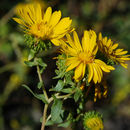en
names in breadcrumbs


Hybrids between Grindelia squarrosa (nuda) and G. arizonica have been recorded from Arizona and New Mexico.
Grindelia squarrosa, also known as a curly-top gumweed or curlycup gumweed, is a small North American biennial or short-lived perennial plant.[2]
G. squarrosa is a decumbent to erect, much-branched perennial herb or subshrub growing up to 100 centimetres (39+1⁄2 inches) tall. The leaves are 1.5–7.5 cm (1⁄2–3 in) long,[3] gray-green, crenate with each tooth having a yellow bump near its tip, and resinous.[4][5]
The plant produces numerous flower heads in open, branching arrays. Each head usually contains 12–40 yellow ray flowers, though sometimes the rays are absent. These surround many small disc flowers. The plant blooms from July through late September.[4][6][5] The brown seed is usually four-angled, with loose scales.[3]
The species is native to western and central North America, from British Columbia east to Québec and New England, and south as far as California, New Mexico, Arizona, Chihuahua, and Texas. The species may possibly be naturalized in much of the eastern part of that distribution.[10][11][4][12]
It is often found in dry, open areas[3] and disturbed roadsides and streamsides, occurring between 700 metres (2,300 feet) and 2,300 metres (7,500 feet) in elevation.[4]
The species is listed by the Lady Bird Johnson Wildflower Center Native Plant Information Network as of "Special Value to Native Bees."[12]
The plant concentrates selenium from the soil,[3] and can be toxic when ingested by cattle, humans, and other mammals.[4]
The flowers and leaves are used by Great Plains Tribes as a medicinal herb to treat illnesses such as asthma, bronchitis or skin rashes.[12][13][14] The powdered flowers were also once smoked in cigarettes to ease asthmatic symptoms.[15]
It is used as a traditional medicinal plant by Shoshone peoples in various regions.[13] The Gosiute language name for the plant is mu’-ha-kûm.[16] The Lakota language name for the plant is pteíčhiyuȟa.
Hispanos of New Mexico boiled the buds to make a drink to treat kidney disorders.[3] Extracts have been made to treat skin irritations, asthma, and rheumatism.[3] The resin has been used to treat poison ivy rashes topically.[17]
The plant is being explored as a potential source of biofuel due to its high content of mono- and di-terpenes which can be converted to a fuel analogous to kerosene or jet fuel.[18] The plant's adaptation to arid climates makes it an attractive option as its cultivation in desert areas would not compete with traditional food crops.
Grindelia squarrosa, also known as a curly-top gumweed or curlycup gumweed, is a small North American biennial or short-lived perennial plant.